1996 CHEVROLET TAHOE overheating
[x] Cancel search: overheatingPage 125 of 403
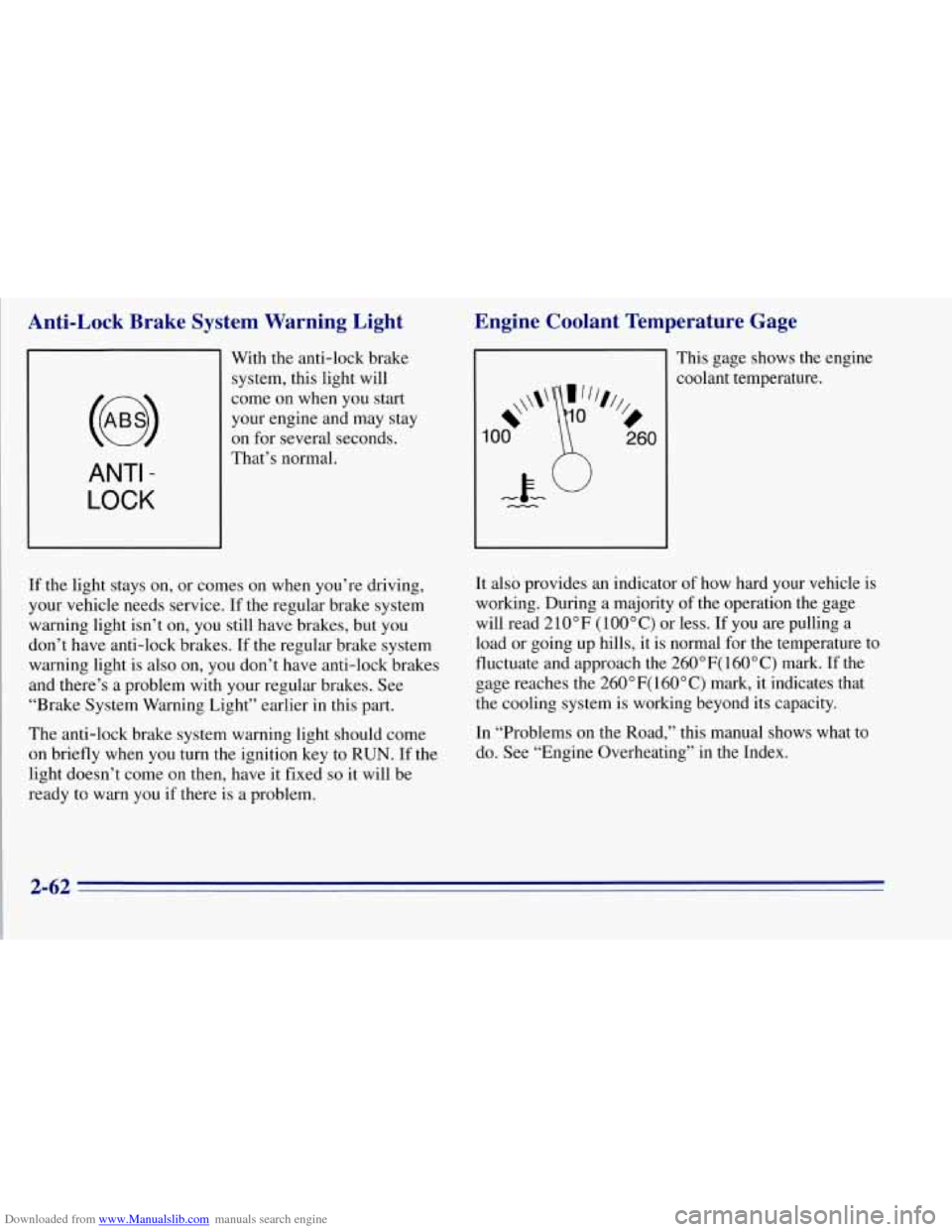
Downloaded from www.Manualslib.com manuals search engine Anti-Lock Brake System Warning Light
ANTI -
LOCK
With the anti-lock brake
system, this light will
come on when you start
your engine and may stay
on for several seconds.
That’s normal.
If the light stays on, or comes on when you’re driving,
your vehicle needs service. If the regular brake system
warning light isn’t
on, you still have brakes, but you
don’t have anti-lock brakes. If the regular brake system
warning light is also on, you don’t have anti-lock brakes
and there’s a problem with your regular brakes. See
“Brake System Warning Light” earlier in this part.
The anti-lock brake system warning light should come
on briefly when you turn the ignition key to RUN. If the
light doesn’t come
on then, have it fixed so it will be
ready to warn
you if there is a problem.
Engine Coolant Temperature Gage
This gage shows the engine
coolant temperature.
It also provides an indicator of how hard your vehicle is
working. During a majority of the operation the gage
will read 2
10 OF ( 100 ” C) or less. If you are pulling a
load or going up hills, it is normal for the temperature to
fluctuate and approach the 260”F( 160°C) mark. If the
gage. reaches the 260”F( 160°C) mark, it indicates that
the cooling system is working beyond its capacity.
In “Problems on the Road,” this manual shows what to
do. See “Engine Overheating” in the Index.
2-62
Page 210 of 403
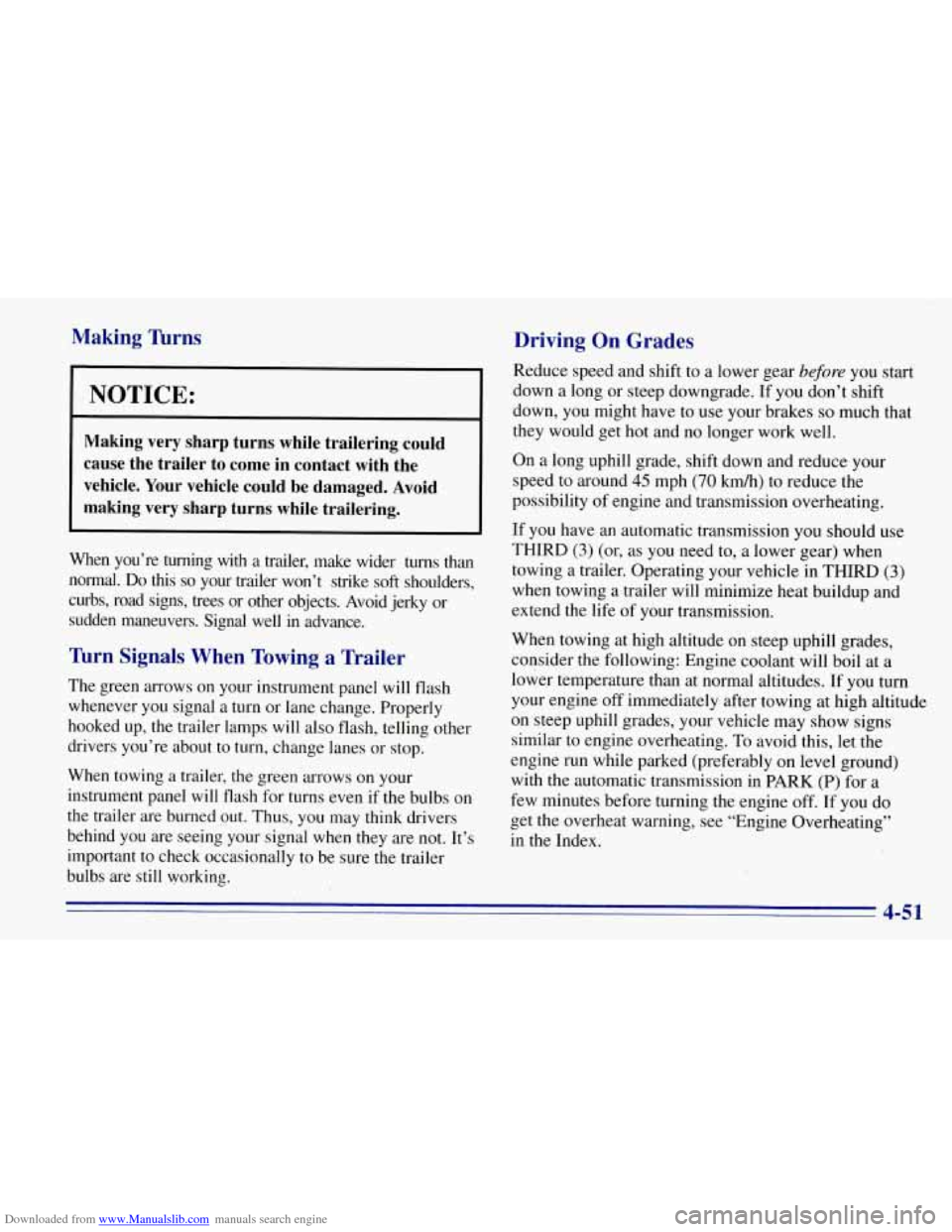
Downloaded from www.Manualslib.com manuals search engine Making Turns
NOTICE:
Making very sharp turns while trailering could
cause the trailer to come in contact with the
vehicle. Your vehicle could be damaged. Avoid
making very sharp turns while trailering.
When you’re turning with a trailer, make wider turns than
normal.
Do this so your trailer won’t strike soft shoulders,
curbs, road signs, trees or other objects. Avoid jerky or
sudden maneuvers. Signal well in advance.
nrn Signals When Towing a Trailer
The green arrows on your instrument panel will flash
whenever you signal
a turn or lane change. Properly
hooked up, the trailer lamps will also flash, telling other
drivers you’re about to turn, change lanes or stop.
When towing a trailer, the green arrows on your
instrument panel will flash for turns even if the bulbs on
the trailer are burned out. Thus, you may think drivers
behind you are seeing your signal
when they are not. It’s
important to check occasionally to be sure the trailer
bulbs are still working.
Driving On Grades
Reduce speed and shift to a lower gear before you start
down
a long or steep downgrade. If you don’t shift
down,
you might have to use your brakes so much that
they would get hot and no longer work well.
On a long uphill grade, shift down and reduce your
speed to around
45 mph (70 km/h) to reduce the
possibility of engine and transmission overheating.
If you have an automatic transmission you should use
THIRD
(3) (or, as you need to, a lower gear) when
towing a trailer. Operating your vehicle in THIRD
(3)
when towing a trailer will minimize heat buildup and
extend the life of your transmission.
When towing at high altitude
on steep uphill grades,
consider the following: Engine coolant will boil at a
lower temperature than at normal altitudes. If you turn
your engine off immediately after towing at high altitude
on steep uphill grades, your vehicle may show signs
similar to engine overheating. To avoid this, let the
engine run while parked (preferably on level ground)
with the automatic transmission in
PARK (P) for a
few minutes before turning the engine off. If you do
get the overheat warning, see “Engine Overheating”
in the Index.
4-51
Page 224 of 403
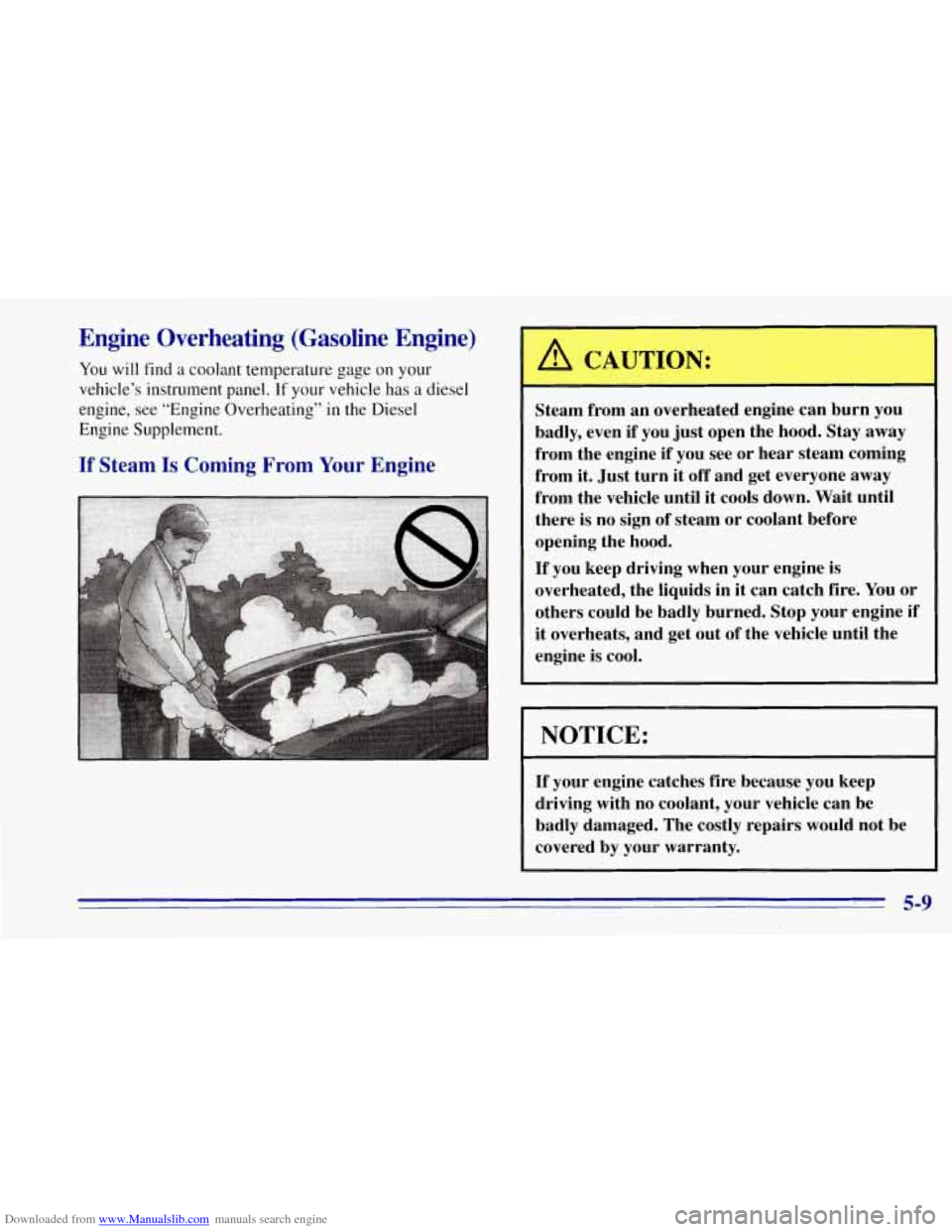
Downloaded from www.Manualslib.com manuals search engine Engine Overheating (Gasoline Engine)
You will find a coolant temperature gage on your
vehicle’s instrument panel. If your vehicle
has a diesel
engine, see “Engine Overheating” in the Diesel
Engine Supplement.
If Steam Is Coming From Your Engine
A CAUTION:
3
Steam from an overheated engine can burn you
badly, even if you just open the hood. Stay
away
from the engine if you see or hear steam coming
from it. Just turn it off and get everyone away
from the vehicle until it cools down. Wait until
there
is no sign of steam or coolant before
opening the hood.
If you keep driving when your engine is
overheated, the liquids in it can catch fire. You or
others could be badly burned. Stop your engine if
it overheats, and get out of the vehicle until the
engine is cool.
I NOTICE:
If your engine catches fire because you keep
driving with no coolant, your vehicle can be
badly damaged. The costly repairs would not be
covered by your warranty.
I 5-9
Page 278 of 403
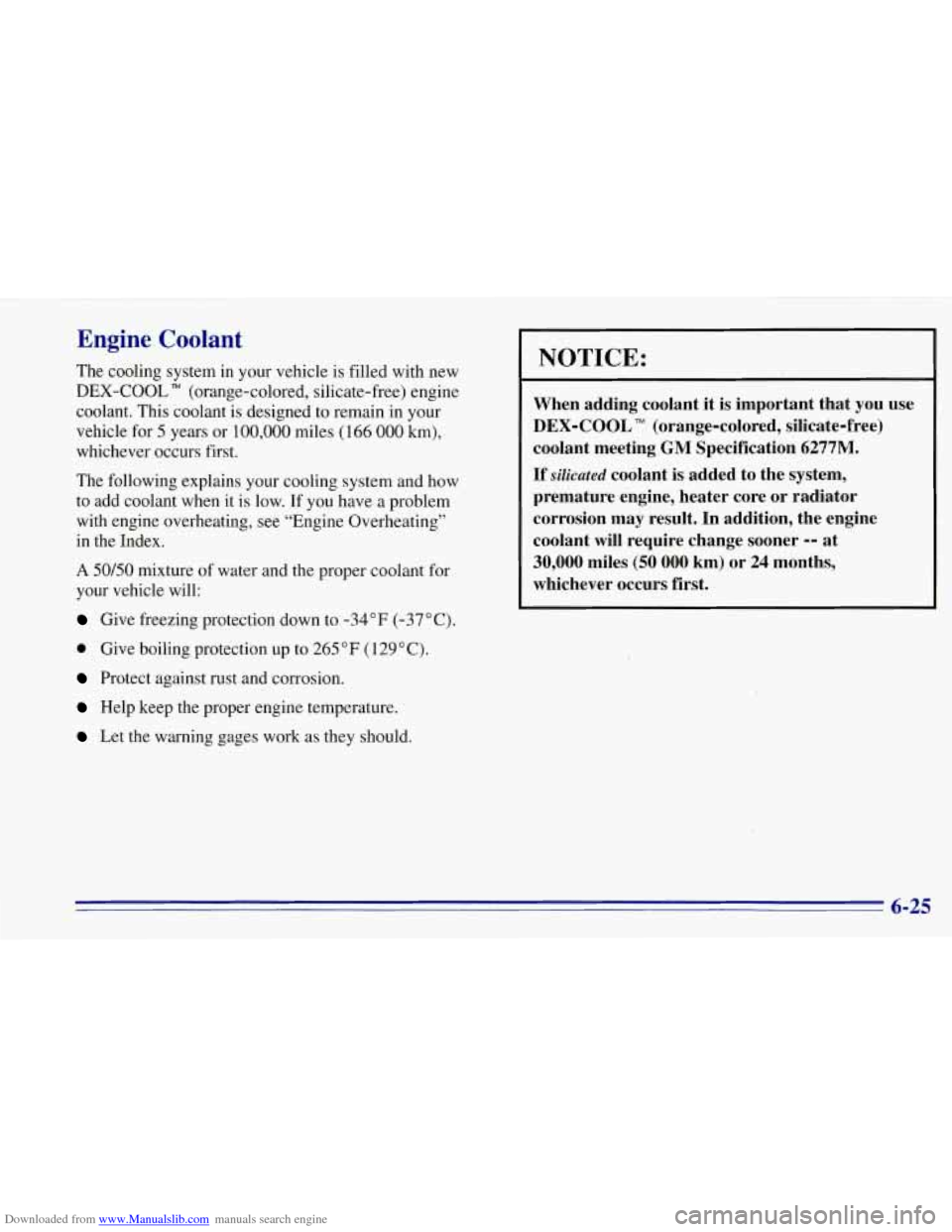
Downloaded from www.Manualslib.com manuals search engine Engine Coolant
The cooling system in your vehicle is filled with new
DEX-COOL TM (orange-colored, silicate-free) engine
coolant. This coolant is designed to remain in your
vehicle for
5 years or 100,000 miles (166 000 km),
whichever occurs first.
The following explains your cooling system and how
to add coolant when it is low. If you have a problem
with engine overheating, see “Engine Overheating”
in the Index.
A 50/50 mixture of water and the proper coolant for
your vehicle will:
Give freezing protection down to -34°F (-37°C).
0 Give boiling protection up to 265 “F (129 ” C).
Protect against rust and corrosion.
Help keep the proper engine temperature.
Let the warning gages work as they should.
NOTICE:
When adding coolant it is important that you use
DEX-COOL (orange-colored, silicate-free)
coolant meeting
GM Specification 6277111.
If silicated coolant is added to the system,
premature engine, heater core or radiator
corrosion may result. In addition, the engine
coolant will require change sooner
-- at
30,000 miles (50 000 km) or 24 months,
whichever occurs first.
6-25
Page 281 of 403
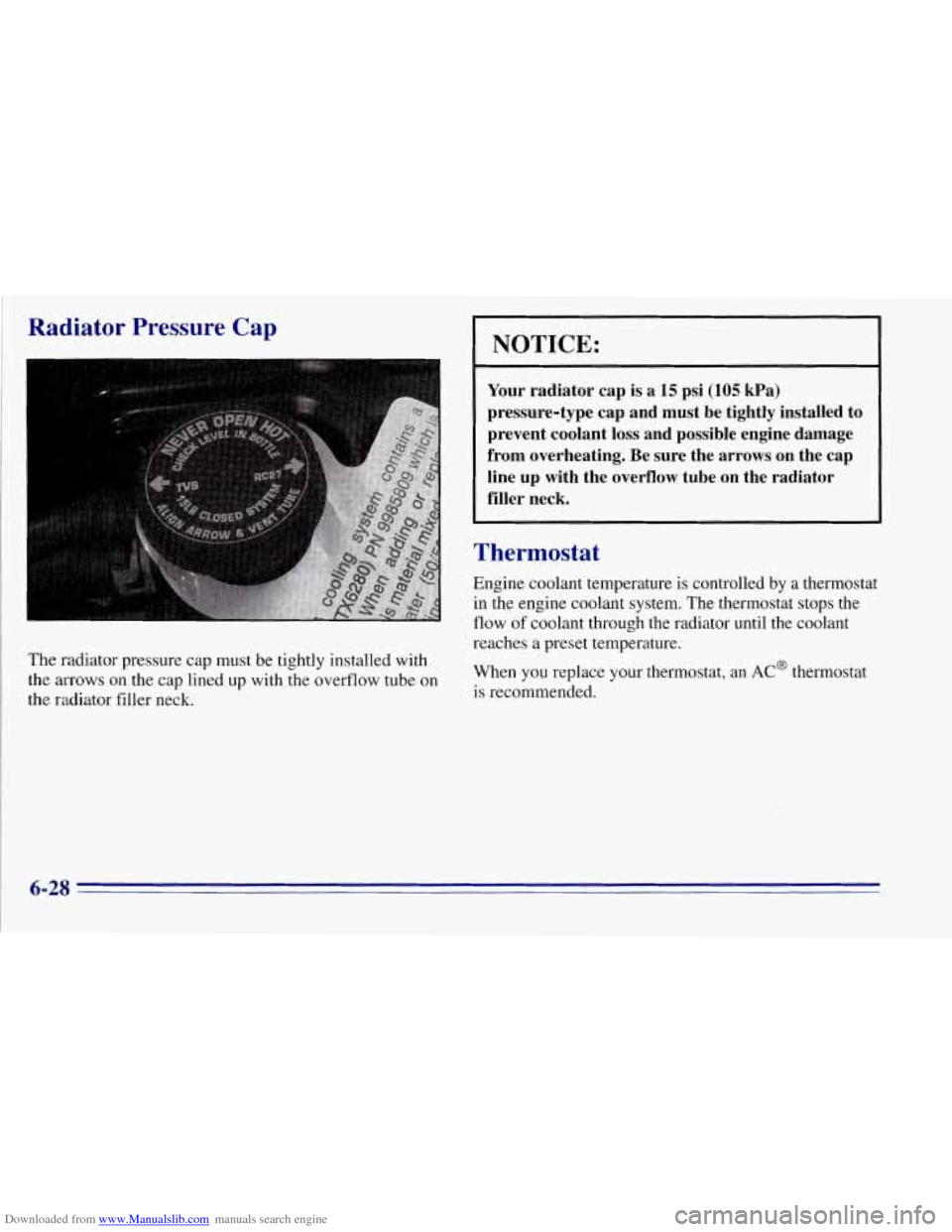
Downloaded from www.Manualslib.com manuals search engine Radiator Pressure Cap
I
The radiator pressure cap must be tightly installed with
the arrows on the cap lined up with the overflow tube on
the radiator filler neck.
NOTICE:
Your radiator cap is a 15 psi (105 kPa)
pressure-type cap and must be tightly installed to
prevent coolant loss and possible engine damage
from overheating. Be sure the arrows on the cap
line up with the overflow tube
on the radiator
filler neck.
Thermostat
Engine coolant temperature is controlled by a thermostat
in the engine coolant system. The thermostat stops the
flow
of coolant through the radiator until the coolant
reaches a preset temperature.
When you replace your thermostat, an
AC@ thermostat
is recommended.
6-28
Page 296 of 403
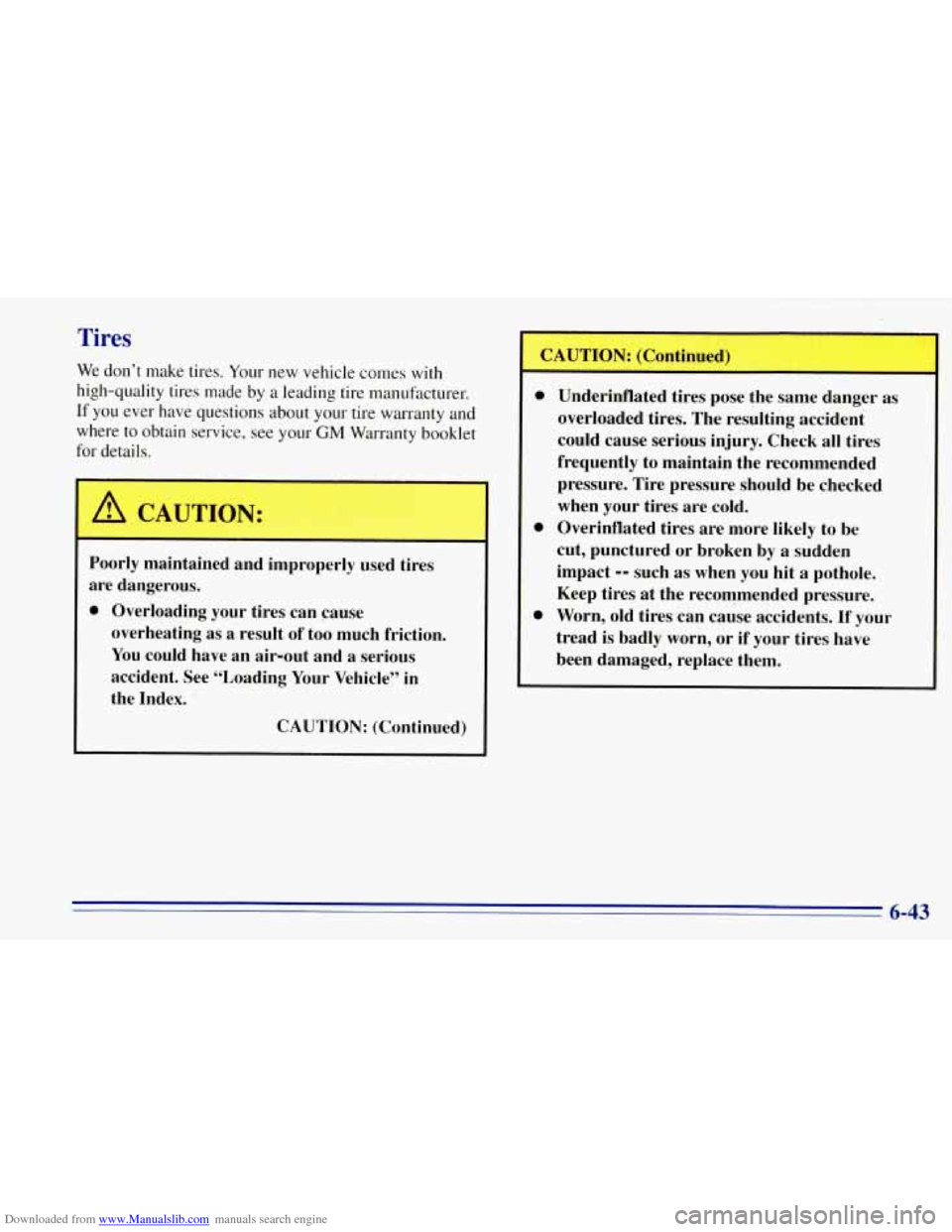
Downloaded from www.Manualslib.com manuals search engine Tires
We don’t make tires. Your new vehicle comes with
high-quality tires made by a leading tire manufacturer.
If you ever have questions about your tire warranty and
where to obtain service, see your
GM Warranty booklet
for details.
A CAUTION:
Poorly maintained and improperly used tires
are dangerous.
0 Overloading your tires can cause
overheating as a result of too much friction.
You could have an air-out and a serious
accident. See “Loading Your Vehicle” in
the Index.
CAUTION: (Continued) CAUTION:
(Continued)
0
0
0
Underinflated tires pose the same danger as
overloaded tires. The resulting accident
could cause serious injury. Check all tires
frequently to maintain the recommended
pressure. Tire pressure should be checked
when your tires are cold.
Overinflated tires are more likely to be
cut, punctured or broken by
a sudden
impact
-- such as when you hit a pothole.
Keep tires at the recommended pressure.
Worn, old tires can cause accidents.
If your
tread is badly worn, or if your tires have
been damaged, replace them.
6-43
Page 393 of 403
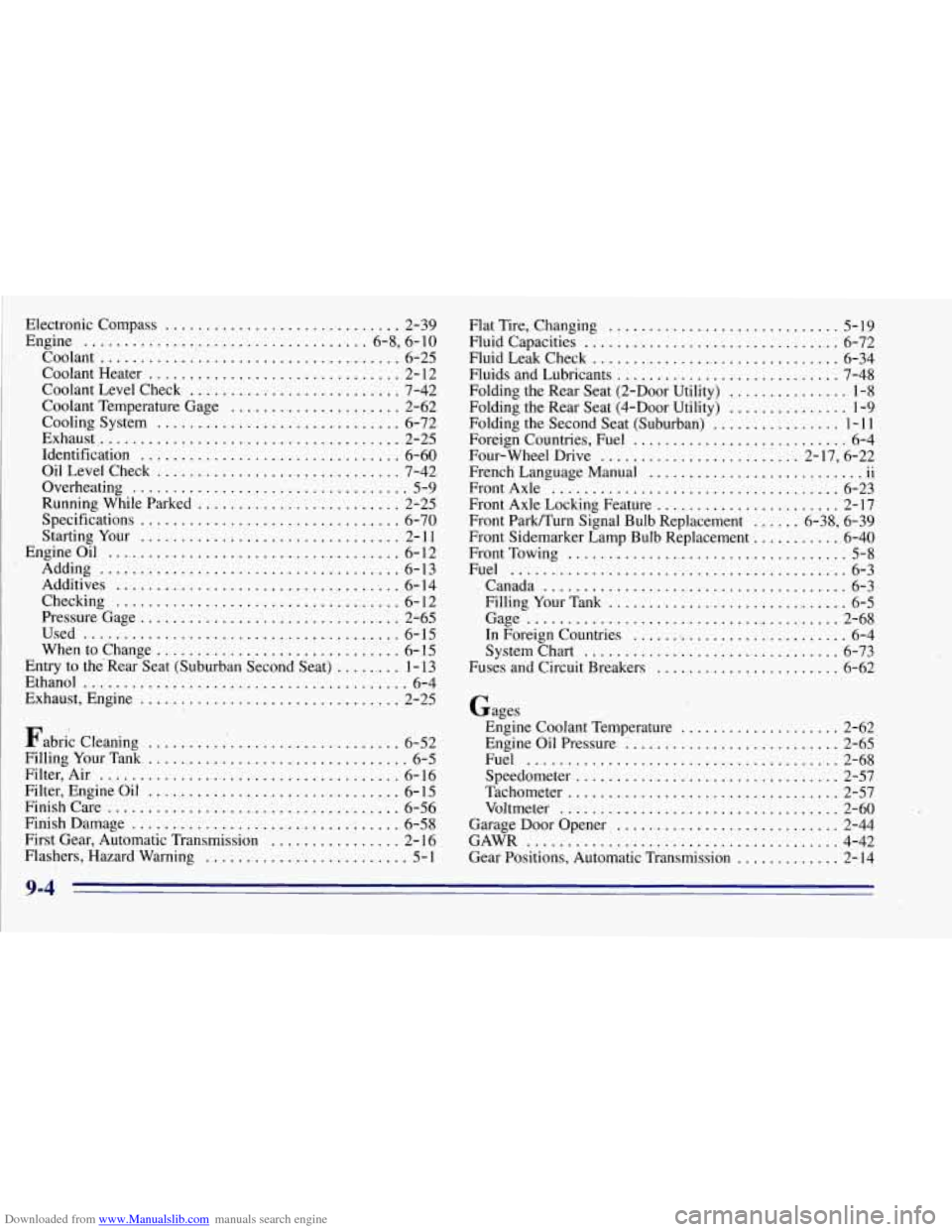
Downloaded from www.Manualslib.com manuals search engine Electronic Compass ............................. 2-39
Engine
................................... 6.8. 6.10
Coolant
..................................... 6-25
Coolant Heater
............................... 2-12
Coolant Level Check .......................... 7-42
Coolant Temperature Gage
..................... 2-62
Cooling System
.............................. 6-72
Exhaust
...................................... 2-25
Identification
................................ 6-60
OilLevelCheck
.............................. 7-42
Overheating
.................................. 5-9
Running While Parked
......................... 2-25
Specifications
. : .............................. 6-70
Starting Your
................................ 2- 11
EngineOil
.................................... 6-12
Adding
..................................... 6- 13
Additives
................................... 6-14
Checking
.................................... 6-12
Pressure Gage
................................. 2-65
Used
....................................... 6-15
Whentochange
.............................. 6-15
.Entry to the Rear Seat (Suburban Second Seat)
........ 1 - 13
Ethanol
........................................ 6-4
Exhaust, Engine
................................ 2-25
Fabric Cleaning
......... .1 ..................... 6-52
FillingYourTank
................................ 6-5
Filter, Air
..................................... 6-16
Filter, Engine Oil
............................... 6- 15
Finish Care
.................................... 6-56
Finish Damage
................................. 6-58
First Gear, Automatic Transmission
................ 2-16
Flashers, Hazard Warning
.......................... 5- 1
Flat Tire. Changing ............................. 5- 19
Fluid Capacities ................................. 6-72
Fluid Leak Check
............................... 6-34
Fluids and Lubricants
............................ 7-48
Folding the Rear Seat
(2-Door Utility) ............... 1-8
Folding the Rear Seat
(+Door Utility) ............... 1-9
Folding the Second Seat (Suburban)
................ 1-11
Foreign Countries. Fuel ........................... 6-4
Four-wheel Drive
......................... 2-17. 6-22
FrenchLanguageManual
11
FrontAxle ..................................... 6-23
Front Axle Locking Feature
....................... 2-17
Front Park/Turn Signal Bulb Replacement
...... 6-38, 6-39
Front Sidemarker Lamp Bulb Replacement
............. 6-40
FrontTowing
................................... 5-8
Fuel .......................................... 6-3
Canada
...................................... 6-3
Filling Your Tank
............................... 6-5
Gage
........................................ 2-68
In Foreign Countries ........................... 6-4
System Chart
................................. 6-73
Fuses and Circuit Breakers
....................... 6-62
.. ...........................
Gages
Engine Coolant Temperature
.................... 2-62
Engine Oil Pressure
i .......................... 2-65
Fuel
....................................... 2-68
Speedometer
................................. 2-57
Tachometer
.................................. 2-57
Voltmeter
................................... 2-60
Garage Door Opener.
............................ 2-44
GAWR
....................................... 4-42
Gear Positions, Automatic Transmission
............. 2-14
9-4 ~ ..